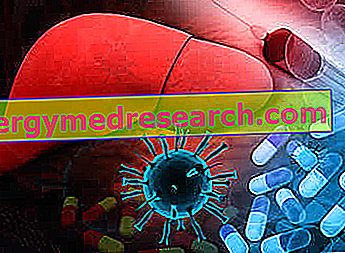What is that
Koch's bacillus - whose scientific name is Mycobacterium tubercolosis - is the microorganism responsible for tuberculosis, a highly contagious infectious disease that - if not properly treated - can prove lethal.

The Koch bacillus is a mycobacterium belonging to the Mycobacteriaceae family and - like all bacteria belonging to this genus ( Mycobacterium ) - it is characterized by a particularly complex and lipid-rich cell wall.
Features
Koch's bacillus is a bacillus, asporiginal, immobile and obliged aerobic. As mentioned, this microorganism has a cell wall with a rather complex structure that gives it different characteristics.
Cell Coating and Characteristics of Koch's Bacillus
The cell wall of the Koch bacillus has the peculiarity of being composed of a high quantity of lipids (indicatively, 50-60% of the dry weight of the cell wall), in particular, fatty acids ( mycolic acids ), waxes and phosphatides.
To be more precise, the cell wall is organized in several layers: immediately above the cell membrane is the peptidoglycan; the layer above the latter is constituted by the Arabinogalactan and, finally, there are the surface glycolipids to which the mycolic acids are anchored. In the cell wall there is also the so-called lipo-arabinosilmannano (LAM) polymer which - inserted in the plasma membrane - passes through the cellular lining throughout its thickness, from the inside to the outside.
This richness of lipids gives the Koch bacillus a series of very specific characteristics which - in principle - are common to all mycobacteria. More precisely, these features consist of:
- Slow growth (replication times ranging from 12 to 24 hours);
- Acid and alcohol resistance;
- Resistance to detergents;
- Resistance to common disinfectants;
- Resistance to drying;
- Antigenicity.
Moreover, again due to this lipid richness, the Koch bacillus is poorly permeable to Gram staining: for this reason, in some cases it may appear as a Gram-positive beat, while in other cases it may be Gram-negative. Because of this behavior, Koch's bacillus is defined as a Gram-variable bacterium.
Finally, it is believed that the lipid component of the Koch bacillus cell wall is also implicated in resistance to several antibiotic drugs.
The antigenicity of the bacillus, on the other hand, is attributable to the protein component of the cellular lining which constitutes about 15% of the wall. The isolated and purified protein portion is called tuberculin or PPD (Purified Protein Derivative) and is used to perform the Mantoux test .
The Cord Factor
The chordal factor is a particular substance formed by the virulent tubercle bacilli (such as the Koch bacillus), which allows bacteria to grow with a particular rope-like formation, otherwise called "palisade".
From the chemical point of view, the cordal factor is a derivative of the mycolic acids (glycolipid 6-6'-dimicolin-treasolo) and - together with the protein component of the cellular coating - is implicated in the virulence of the Koch bacillus.
Infection and Tuberculosis
As mentioned, Koch's bacillus is the microorganism responsible for tuberculosis.
Koch's bacillus infection develops in most cases (80-90%) in the lungs, giving rise to pulmonary tuberculosis . Despite this, the bacillus - through the blood and lymphatic vessels - can reach other body areas, such as bones, brain, eyes, skin and kidneys (renal tuberculosis). In these cases, therefore, we talk about extrapulmonary tuberculosis .
Pathogenesis
In pulmonary tuberculosis, the Koch bacillus is located at the level of the alveoli, where it is phagocytized by alveolar macrophages.
However - thanks to the particular structure of the cell wall and the presence of the cordal factor - the bacillus is able to inactivate the macrophages, since it causes the blockage of the phagosome-lysosome fusion, a fundamental process for the elimination of phagocytosed pathogens.
This block, therefore, allows the bacterium to survive and replicate inside the inactivated macrophages. This intracellular replication leads to the formation of new bacilli, cellular and bacterial debris, and causes the triggering of a cell-mediated immune response that involves the activation of T lymphocytes and macrophages.
The infection and the consequent activation of the immune system lead to the formation of the so-called granulomas or tubercles (from which the name "tuberculosis" derives). At the center of the tubercles there is often a caseous necrosis surrounded by Langhans cells (multinucleated giant cells in which the nuclei are arranged in a horseshoe), in turn surrounded by T lymphocytes and plasma cells, all enclosed by a layer of fibrous tissue .
The formation of granulomas occurs substantially because the immune system is not capable of eliminating the pathogen. For this reason, the most effective strategy for curbing the infection is to create a "shell" of tissue within which the Koch bacillus is isolated from the rest of the body.
Bacilli present in granulomas can be killed, or they can remain latent for long periods of time (months or even years). In the latter case the patient may be positive for the tuberculosis test, but will not show symptoms and will not be contagious (for more information: Inactive tuberculosis and active tuberculosis).
Contagion and Transmission
The transmission of Koch's bacillus infection from one individual to another occurs through droplets of saliva emitted by the subjects infected with phonation, coughing, sneezing, etc.
However, the ability to infect other individuals can vary, as it depends on several factors, such as the stage of the disease, the concentration of Koch's bacillus within the droplets of saliva and the presence of any antibiotic therapies in place. In fact, in general, it is believed that a patient stops being contagious after two weeks of therapy.
Care and Prevention
The treatment of Koch's bacillus infection takes a very long time and the combination of a series of antitubercular active ingredients. The most used are isoniazid, rifampicin and ethambutol .
Other first-line drugs used in the treatment of infections caused by the Koch bacillus are streptomycin, rifabutin and pyrazinamide.
The prevention of Koch's bacillus infections, on the other hand, is carried out by administering the appropriate vaccine: the BCG vaccine . The latter is constituted by the bacillus of Calmette-Guérin, a microorganism derived from the Mycobacterium bovis strains.



